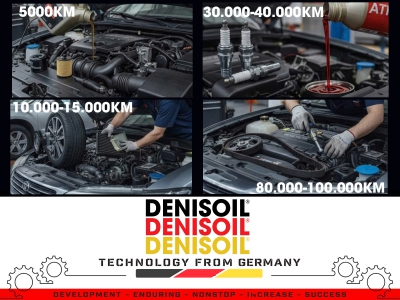WHITE SMOKE FROM MOTORBIKES – SYMPTOMS, CAUSES, AND TECHNICAL SOLUTIONS
DENIS OIL – Premium Lubricants for Technical Experts
1. White smoke from motorcycles – When is it normal, and when is it abnormal?
White smoke can be categorized into two situations:
• Temporary white smoke on cold start: In cold weather, condensation inside the exhaust system evaporates as the engine warms up. This is just water vapor—not actual smoke from fuel/oil combustion—and usually disappears after a few minutes.
• Persistent white smoke during operation: If white smoke continues with a burnt smell after warming up, it indicates that engine oil is leaking into the combustion chamber and burning with the air-fuel mixture.
2. In-depth technical causes of white smoke:
a. Worn piston rings:
Piston rings seal the gap between the piston and the cylinder wall, preventing oil from entering the combustion chamber. When worn, oil escapes into the combustion chamber and burns, producing white smoke.
• There are three types of piston rings: compression ring, oil control ring, and intermediate ring.
• A faulty oil ring fails to scrape oil back to the crankcase, leading to unintended burning.
b. Valve stem seal leakage:
Valve stem seals prevent oil from flowing from the cylinder head into the combustion chamber via the valve stem. When hardened, aged, or torn, oil leaks into the chamber, causing white smoke.
c. Worn cylinder:
Cylinder walls can wear out over time due to poor-quality oil or dirt contamination, creating gaps that piston rings cannot fully seal. This causes pressure loss and oil leakage into the combustion chamber.
d. Broken or incorrectly installed piston rings:
Cracked, rotated, or improperly installed rings during engine assembly will compromise the sealing function and allow oil to enter the combustion chamber.
3. Consequences if not repaired in time:
• Rapid oil consumption and frequent refilling.
• Reduced engine power, increased fuel consumption, hard starting.
• Carbon deposits on the combustion chamber, spark plugs, and exhaust manifold, causing ignition issues.
• Long-term damage to pistons, rings, and cylinders—possibly requiring a full engine overhaul.
• Environmental pollution from incompletely burnt oil fumes.
4. Technical solutions:
Due to the involvement of precision mechanical parts, repairs should be handled by professional technicians. Usual steps include:
• Compression testing using specialized gauges to assess chamber sealing.
• Engine disassembly – inspecting pistons, rings, and cylinder wear.
- If rings are worn: replace with new ones.
- If cylinder is lightly scratched: hone and install new piston + rings.
- If heavily worn: replace the cylinder-piston assembly.
• Inspect cylinder head: Replace hardened or torn valve stem seals.
• Reassemble according to technical standards, ensuring all clearances are within tolerance.
5. How to prevent white smoke from motorbikes?
• Use high-quality lubricants like DENIS OIL, which offer superior lubrication, anti-wear protection, piston deposit control, and extended engine life.
• Follow a regular maintenance schedule: timely oil changes, air filter, spark plug, and valve checks.
• Avoid engine overheating, overloading, or operating in dusty environments.
• Never let the oil run dry—it can cause piston overheating and wear.
Final Note from DENIS OIL:
Understanding technical causes and symptoms helps you effectively address white smoke issues and prevent costly damage. With our technical expertise and premium engine oils, DENIS OIL supports professionals and experienced users to ensure your engine runs smoothly, cleanly, and at peak performance.
 Tiếng Việt
Tiếng Việt
 Chinese
Chinese
 English
English







